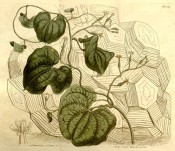Dioscorea elephantipes (L’Hérit.) Engl.
Frost-tender, slow-growing, deciduous, climbing perennial with a partially buried, pyramidal, heavily fissured woody tuber, blue-green, heart-shaped leaves and dark-spotted, greenish-yellow flowers in summer. [RHSE, Hortus].
Horticultural & Botanical History
‘From the uncouth massive appearance as well as colour of the rootstock, our plant has acquired at the Cape of Good Hope the appellation of “Elephant’s Foot”; in other respects, it very much resembles the common black Bryony (Tamus communis) of our hedges. The stem, which is about the thickness of the little finger at the base and twining, requires support, by the help of which we have seen it reach the height of about eight feet. Found in the neighbourhood of Cape Town by Mr. Masson, by whom it was introduced into the Kew Gardens in 1774, where a male plant bloomed in 1783.’ [BM t.1347/1811]. ‘The finest specimen of this is said to be in the Royal Botanic Gardens, Kew; its age is unknown.’ [Gard. Chron. 1853]. BR f.921/1825.
History at Camden Park
Listed only in the 1850 catalogue.
Notes
Published Jan 20, 2009 - 05:19 PM | Last updated Sep 30, 2011 - 05:12 PM
| Family | Dioscoreaceae |
|---|---|
| Category | |
| Region of origin | South Africa, Cape district |
| Synonyms |
|
| Common Name | Elephant’s foot, Hottentot bread |
| Name in the Camden Park Record | Testudinaria elephantipes
|
| Confidence level | high |


